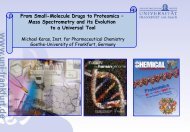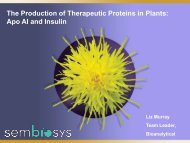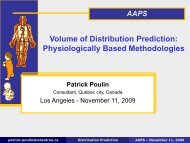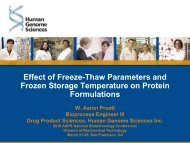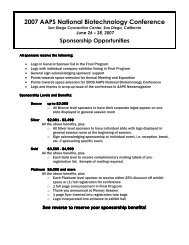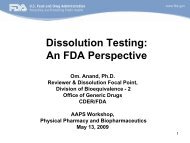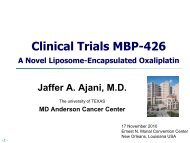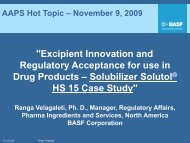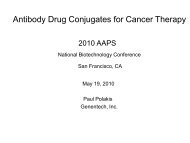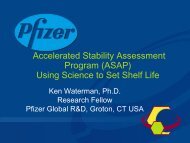Early Development of Poorly Water-Soluble NCEs - American ...
Early Development of Poorly Water-Soluble NCEs - American ...
Early Development of Poorly Water-Soluble NCEs - American ...
- No tags were found...
Create successful ePaper yourself
Turn your PDF publications into a flip-book with our unique Google optimized e-Paper software.
<strong>Early</strong> <strong>Development</strong> <strong>of</strong> <strong>Poorly</strong> <strong>Water</strong>-<strong>Soluble</strong><strong>NCEs</strong>: Potential Advantages <strong>of</strong>Keeping <strong>Development</strong> Activities in houseAbu T. M. Serajuddin, Ph.D.St. John‟s University, Qeens, New YorkE-mail: serajuda@stjohns.edu; Phone: 718-990-7822
PercentRecent Trends in NCE Solubility5040Two-thirds (?):Insoluble orPracticallyInsolubleVery slightlysoluble orsoluble3020100100µg/mLSolubilitySolubility < 1 μg/mL (0.001 mg/mL) is common3Source: Personal experience, literature data and anecdotal information
<strong>Development</strong> Strategies vsOutsourcing OptionsCommon strategies to overcome impacts <strong>of</strong>low solubility on product development:– Salt formation– Particle size reduction• Milling• Nanosizing– Conversion to amorphous form/high-energy solid– Solid dispersion– Solubilization– Lipid-based drug delivery4To save time and resources in productdevelopment, relatively simpler approachesshould be tried first.– Which <strong>of</strong> them should we outsource?
Salt Formation
How Does Salt Formation IncreaseDissolution Rate?J =dM=dtDAh (C s - C )…. by changingmicroenvironmentalpH and solubility•Saturate•Supersaturate,and/or•Fine precipitateDiffusion Layer ModelSolid(salt)C s, h=0 >>StagnantDiffusionLayerC s, bulk mediumBulk LiquidPhase(Dissolution Medium)C6h
Precipitated Free BaseLimitation <strong>of</strong> Salt FormationDiffusion Layer ModelWhen the intrinsicsolubility is very low, theprecipitated free basecoats the dissolvingsurface, preventingfurther dissolution <strong>of</strong> salt.Please note: Precipitationat the surface, not in thebulk medium. No increasein surface area.Solid(salt)XC s, h=0 >>XStagnantDiffusionLayerC s, bulk mediumBulk LiquidPhase(Dissolution Medium)Ch7
8Nanotechnology
Nanoparticle FormationCommon Techniques9– Wet milling– High pressure homognization– Supercritical fluid technologies• Solvent• Anti-solvent– Liquid precipitation– Nano-emulsion or suspension• Lipid-surfactant systems• Solid dispersion system
10High-energy Solid
Amorphous FormCompound Forms Solubility Temp.Ratios (calc)Indomethacin Amorphous/γ-Crystal 25 - 104 25 CGlibenclamide Amorphous/Crystal 112 - 1652 23 CGlucose Amorphous/Crystal 16 - 53 20 CGrise<strong>of</strong>ulvin Amorphous/Crystal 38 - 441 21 CHydrocholoro Amorphous/Crystal 21 – 113 37 C-thiazideIopanoic Acid Amorphous/Crystal 12 – 19 37 CPolythiazide Amorphous/Crystal 48 - 455 37 CRef: Hancock & Parks, Phram. Res, 17, 397 – 404, 200011
Heat content(enthalpy, H)Advantage <strong>of</strong> Solid Dispersion: BetterStability than Purely Amorphous SystemStorage temperatureDrug onlyDrug - polymermiscible blendElevated T g12Courtesy: M. VasanthavadaT g (drug)TemperatureT g (mixture)
What is Solid Dispersion ?“the dispersion <strong>of</strong> one or more active ingredients in an inert carrier or matrix,where the active ingredients could exist in finely crystalline, solubilized oramorphous state” - Chiou and Riegelman, J Pharm Sci 1971, 60, 1281-1302Drug(crystalline) +Carrier(amorphous)No miscibilityPartial miscibilityComplete miscibility
Preparation <strong>of</strong> Solid Dispersion –Solvent EvaporationTHydrophobic crystalline drugRemove thesolventHydrophilic carrierDissolve inorganic solventSolid dispersion(molecularlydispersed oramorphous drugin hydrophiliccarrier matrix)14
Solid Dispersion by Solvent EvaporationMajor Solvent EvaporationTechnologies– Rotary evaporation– Spray drying– Spray granulation• Bottom spray• Top sprayRef: Timpe et al., A Novel Solvent-Based Fluidized Bed Wet Granulation Process forSolid Dispersions, <strong>American</strong> Pharmaceutical Review, 2008http://www.americanpharmaceuticalreview.com/15
Preparation <strong>of</strong> Solid Dispersion –Melt Filling• Batch process• One-step process to final dosage formTransfer <strong>of</strong> molten drug/carrierliquid into capsules byliquid capsule filling processMolten carrier dissolvingdrug in carrierCooling and solidification16
Solid Dispersion byMelt Extrusion17
Solid Dispersion by Melt ExtrusionTechnologyMelt extrusion is a single-step process ideally suitableto manufacture solid dispersionHomogeneous mixture <strong>of</strong> active, polymerplasticizer, surfactantRef: Adapted from J. Kowalski (Novartis) presentation18
Challenges with Melt ExtrusionFeed portHeated barrel withtemperature zonesMotor19Conveying zoneMixingzoneDie• Relatively short dwell time in the heated barrel• Temperature must be higher than the melting temperature (~15-20°C) for complete conversion to amorphous form and ease<strong>of</strong> processing (reduced viscosity)• Risk associated with chemical stability – thermo-labilecompounds• High Tg <strong>of</strong> commonly used polymers (150-160 °C) – needsuitable plasticizers; temperature must be > Tg• Lack <strong>of</strong> miscibility between drug and polymer
Nanoemulsion/Solid NanoemulsionPreconcentrates20
What is Nanoemulsion? -„Cyclosporine A‟ExampleWithoutdilutionCyclosporin ASandimmune ® Neoral ®20 – 150 nm( < 200 nm)DilutionwithwaterMicroemulsion(o/w)Ref:A. Meinzer et al,BT Gattefosse 88 :21-26, 199521
Limitation <strong>of</strong> Lipid-based DrugDelivery Systems• Selection <strong>of</strong> appropriate lipids andsurfactants• Low or limited solubility <strong>of</strong> drugs inlipids, lipid-like carriers andsurfactants• Need for liquid formulations or s<strong>of</strong>tgelatin encapsulation22
Solid Nanoemulsion PreconcentrateSolid dispersion Solid preconcenrate LiquidpreconcentrateOCF 3H 3CNHNHOO CH 3Compound AComponentSolid MicroemulsionPreconcentrateCompound A (%w/w) 4 8Capmul PG8 (%w/w) 28.8 27.6Cremophor EL(%w/w)28.8 27.6PEG 3350 (%) 38.4 36.823Ref: Li et al., J. Pharm. Sci., 98:1750-1763, 2009
Outsourcing <strong>of</strong> <strong>Early</strong> <strong>Development</strong> <strong>of</strong><strong>Poorly</strong> <strong>Water</strong>-soluble <strong>NCEs</strong>24Concluding Remarks• Two-thirds <strong>of</strong> <strong>NCEs</strong> are poorly water-soluble.• Almost one-third <strong>of</strong> <strong>NCEs</strong> are extremely waterinsoluble(solubility in water:



